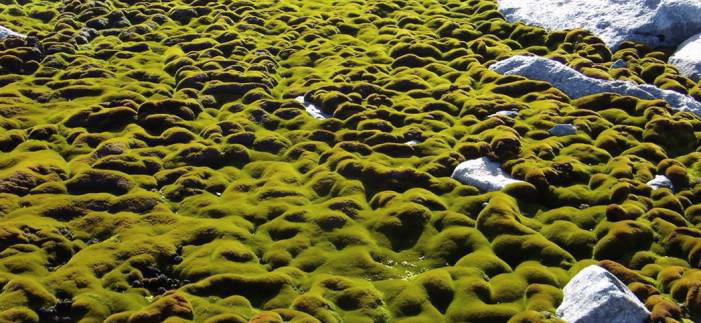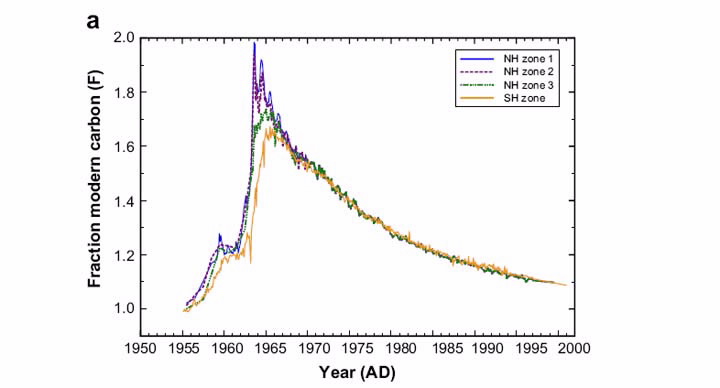Bomb spikes’ found in the shoots of Antarctic moss, one of the smallest and last untouched species on the planet, are providing startling revelations of the impacts of future climate variability for Earth’s biodiversity.
 |
| An image of moss, the most dominant plant life in Antarctica |
Antarctica is often considered the last untouched wilderness, free of the impacts of human activities, and highly sensitive to any changes in climate. In what is considered world first research, scientists from Australia are now dispelling that myth suggesting some of the continent’s most dominant plant species are showing the symptoms of climate variability.
Scientists carbon dating and measuring the depth of moss colonies, considered the old growth forests of Antarctica in miniature, have observed up to a seven-fold slowdown in the growth of some species from changes in temperature and wind speeds.
The findings are startling and provide valuable insights into the potential effects of climate variability this century. That includes potential massive disruptions in growth patterns for the world's vegetation, based on water availability, with the obvious flow-on affects that could be expected further up the food chain.
The discovery was made by a team of researchers from ANSTO and environmental scientists from the University of Wollongong who have been conducting the research for a number of years.
Their studies involved collecting moss turf ‘cores’ from five sites in East Antarctica, four of the sites less than 5km from Casey.
The samples were then analysed using ANTARES, an accelerator located within the Institute for Environmental Research at ANSTO, to carbon date each example to estimate the growth rates of moss shoots and compare this data with meteorological data compiled in the area.
The results were startling suggesting that the growth of Antarctic plant life in some areas had been stunted as water became scarce as a result of environmental shifts, including higher wind speeds, more evaporation and less moisture.
Radiocarbon bomb spikes found in the shoots of moss by researchers from ANSTO and environmental scientists from University of Wollongong are revealing the effects of Antarctic climate variability.
Bomb spike revelations
According to Dr Quan Hua from the Institute for Environmental Research at ANSTO, the key to their discovery was using radiocarbon deposits found in moss shoots that dated back to the time of nuclear weapons tests from the 1950s and 1960s.
The amounts found were unprecedented and acted as a natural marker determining the age of moss species, which could then be used to determine changes in growth rates over their life span.
“Above ground nuclear testing in the late 1950s and early 1960s resulted in a dramatic increase in atmospheric radiocarbon (14C) known as the 14C ‘bomb spike’”, Dr Hua said.
Accurately dating the age of moss shoots along their stems using the 14C ‘bomb spike’, as Dr Hua asserts, basically takes a negative (the bomb tests) and turns it into a positive.
“Our hypothesis was that the atmospheric 14C signal would be faithfully retained along Antarctic moss shoots (gametophytes) as evidenced by the presence of the 14C bomb spike,” he said.
 |
Regional tropospheric 14C curves for the period AD 1955–2001 for four different zones (Northern Hemispheric zones 1–3 and Southern Hemispheric zone). |
Research results
Growth rates over the last 50 years were determined by plotting the calibrated 14C age of the core section, which was the peak of bomb spike, against the distance from the growing tip of the shoot core. Professor Sharon Robinson from University of Wollongong Institute for Conservation Biology and Environmental Management (School of Biological Sciences) was the lead researcher on the project.
Along with her team, Professor Robinson’s research showed that in some of the study species the peak of the radiocarbon bomb spike was found just 15 mm from the top of the 50 mm shoot suggesting that these plants may be more than 100 years old.
“Accurate dating along the moss stem allows us to determine the very slow growth rates of these mosses (ranging from 0.2 to 3.5 mm per year),” Professor Robinson said.
“Remarkably, these plants were already growing during the heroic age of Antarctic exploration. In terms of age these mosses are effectively the old growth forests of Antarctica -- in miniature.”
To ensure a comprehensive understand of the factors that could impact potential growth rates, moss samples were collected from five sites in East Antarctica in early 2005. Four sites were in the Windmill Islands region; two on Clark Peninsula [Antarctic Specially Protected Area (ASPA) 136] and two on Bailey Peninsula (ASPA 135 and Red Shed). The fifth site was at Grimmia Gorge in the Vestfold Hills.
Once they’d calibrated the 14C ages of each species, considerable variation in growth rates over time in each were identified. For instance, all four species found from the Windmill Islands experienced slower growth rates in the 1990s and 2000s, compared with 1980. Samples from the Vesthold Hills region showed higher growth rates in recent decades.
Dr Hua attributed the variation in growth to the differences in each species “microclimate”.
 |
| Changes in growth rate of mosses from the Windmill Islands and Vestfold Hills over time. |
Growth rates were estimated from the gradient of a spline fitted to plots of the calibrated 14C age of shoot core sections against their distance from the growing tip. Clark – C. purpureus (open squares), S. antarctici (closed squares); Grimmia Gorge – B. recurvirostre (open triangles), B. pseudotriquetrum (closed triangles).
Note that Clark samples are from separate sites on Clark Peninsula. x-axis error bars represent calibrated 14C age range at 2r, y-axis error bars represent the maximum difference between growth rate estimates from the spline curve using upper and lower limits of the calibrated 14C age range compared with the mean 14C age.
Some of the most dramatic variations were identified in ASPA 135 and Clark where growth rates were higher in the late 1950s and decreased more than sevenfold (ASPA 153) and threefold (Clark), respectively by the 1980s. Sample ASPA 135 experienced growth rates of 3.5mm per year in the 1950s with a dramatic fall in only a short period with growth rates dropping to as low as 0.5mm per year in the mid-1960s.
“Our results point to a profound influence of recent climate variability on the Antarctic flora indicating the effects of temperature and wind speed are most likely due to the impact of these variables in water availability,” he said.
Although increased temperature and precipitation in polar regions, due to climate variability, were predicted to increase growth rates, the scientists found that at some sites growth rates had actually declined since the 1980s. The researchers suggest that this was likely due to moss beds drying out, which appeared to be caused by increased wind speeds around Antarctica linked to the Antarctic ozone hole.
Although there was no clear evidence of warming from station meteorological records in the region, recent studies of ice-sheet balance have shown accelerated ice loss since 2006 from the East Antarctic sheet in the vicinity at Casey Station and infrared satellite data suggest that, contrary to previous reports, East Antarctica has warmed by 0.1 oC per decade since 1957.
“The environmental factor most responsible was increasing wind speeds. Surface wind speeds have increased over the Earth’s oceans over the past couple of decades and around the Antarctic continent as a result of ozone depletion and increasing greenhouse gases.
“The result leads to a negative impact on water availability,” Dr Hua said.
Next steps
Results from their research were published in the January 2012 issue of Global Change Biology.
Professor Robinson and the team have received an ARC grant (2011-2013) to conduct further research.
She will work with collaborators from ANSTO and the Universities of Wollongong, Tasmania and Cambridge with results from their investigations not expected until at least 2013.
Published: 24/04/2012


